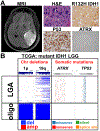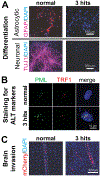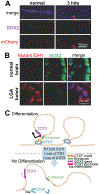Molecular Pathogenesis of Low-Grade Glioma
- PMID: 30470401
- PMCID: PMC6260953
- DOI: 10.1016/j.nec.2018.08.011
Molecular Pathogenesis of Low-Grade Glioma
Abstract
Advances in genome sequencing have elucidated the genetics of low-grade glioma. Available evidence indicates a neomorphic mutation in isocitrate dehydrogenase (IDH) initiates gliomagenesis. Mutant IDH produces the oncometabolite 2-hydroxyglutarate, which inhibits enzymes that demethylate genomic DNA and histones. Recent findings by the authors and others suggest the ensuing hypermethylation alters chromatin conformation and the transcription factor landscape in brain progenitor cells, leading to a block in differentiation and tumor initiation. Work in preclinical models has identified selective metabolic and molecular vulnerabilities of low-grade glioma. These new concepts will trigger a wave of innovative clinical trials in the near future.
Keywords: Astrocytoma; Low-grade glioma; Mutant IDH; Oligodendroglioma.
Copyright © 2018 The Author(s). Published by Elsevier Inc. All rights reserved.
Figures




References
-
- Grier JT, Batchelor T. Low-grade gliomas in adults. Oncologist. 2006;11(6):681–693. - PubMed
Publication types
MeSH terms
Substances
Grants and funding
LinkOut - more resources
Full Text Sources
Medical

